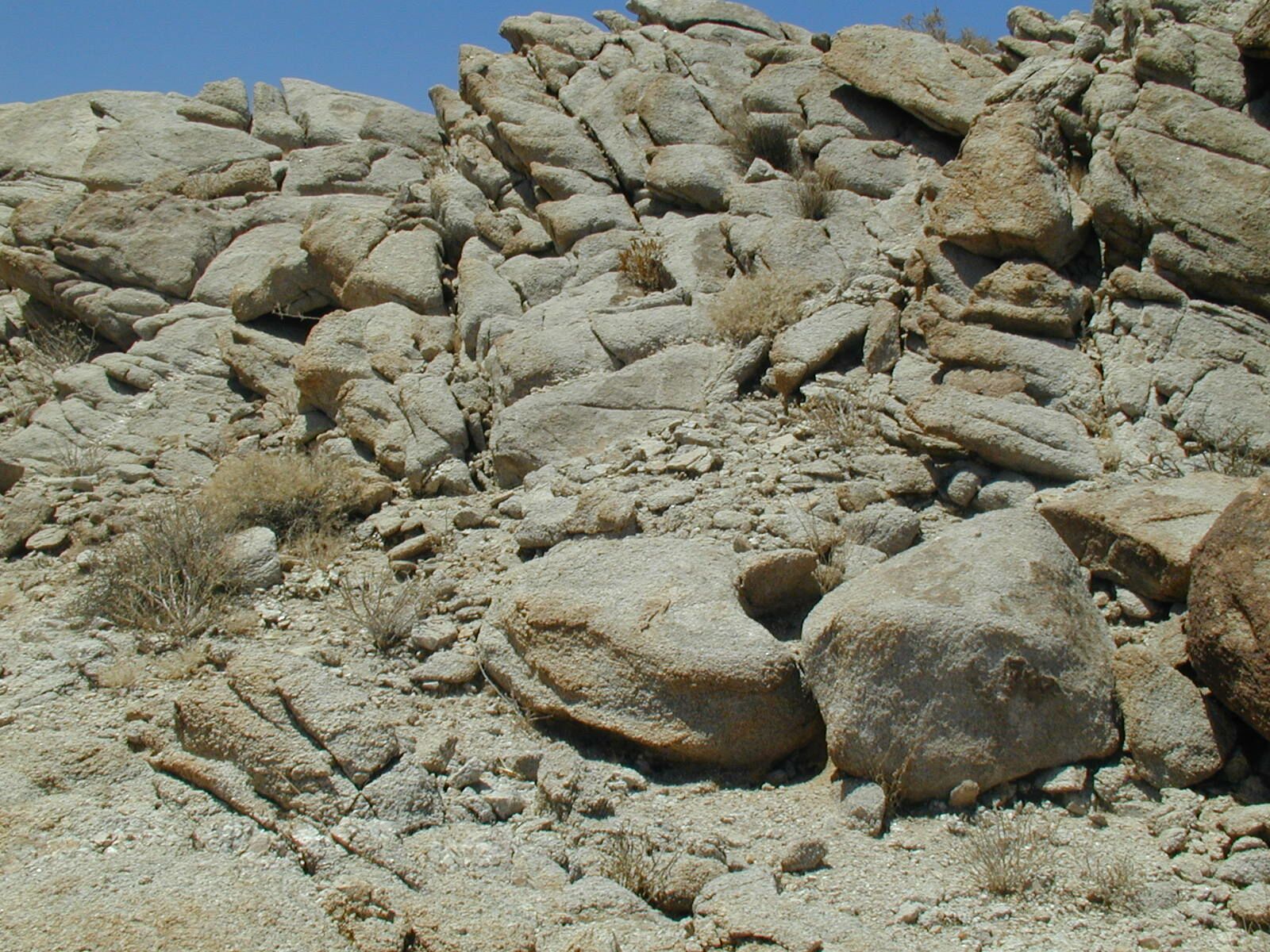1. Introduction: Natural Selection in Gene Pools
In the first tutorial in this unit, we saw how Darwin (and Wallace) proposed a theory of natural selection that explains how adaptation could arise through natural processes. As Darwin wrote in On the Origin of Species
It may metaphorically be said that natural selection is daily and hourly scrutinizing, throughout the world, the slightest variations; rejecting those that are bad, preserving and adding up all that are good; silently and insensibly working, whenever and wherever opportunity offers, at the improvement of each organic being in relation to its organic and inorganic conditions of life.
Darwin was able to develop his theory despite being unaware of how genes are transmitted from one generation to the next. Now, we’ll use what we’ve learned about alleles in populations to look again at natural selection, this time from a population genetics perspective.
2. Natural Selection Increases the Frequency of Beneficial Alleles and Decreases the Frequency of Harmful Alleles
Natural selection is frequently summarized as “survival of the fittest.” In a population genetics context, you can think of natural selection in terms of phenotypes and genotypes. Individuals who have phenotypes with some type of advantage will have a higher chance of surviving and reproducing. During reproduction, the alleles that code for these beneficial traits will get passed on to the next generation. Conversely, individuals with disadvantageous phenotypes will have a lower chance of surviving and reproducing. Because the alleles that code for disadvantageous phenotypes have a lower probability of getting passed on to the next generation, these alleles, over time, decrease in frequency.
Thus, over time, natural selection changes a population’s gene pool so that alleles that code for beneficial phenotypes become more frequent, and alleles that code for harmful phenotypes become less frequent. The key idea is that through the selection of phenotypes, the allele frequencies in a gene pool change.
So what is it that evolves? Often, the word “evolve” is used as a synonym for “change” (such as “Her technique evolved over the course of her career.”). But in a biological context, we need to be more precise. Individual organisms don’t evolve. They get selected for survival (or they get eliminated from the population). The unit of evolution in biology is the population. Commit this to memory: Individuals get selected; populations evolve.
3. Natural Selection Case Study # 1: Peppered Moths

Let’s apply this population genetics perspective on natural selection to a famous case study of evolutionary biology: the peppered moth, Biston betularia. This species lives in Northern England, and has two forms: mostly light-colored, with specks of black (which is where the “peppered” part of the name comes from), and a much darker form. The allele for dark coloration is dominant.
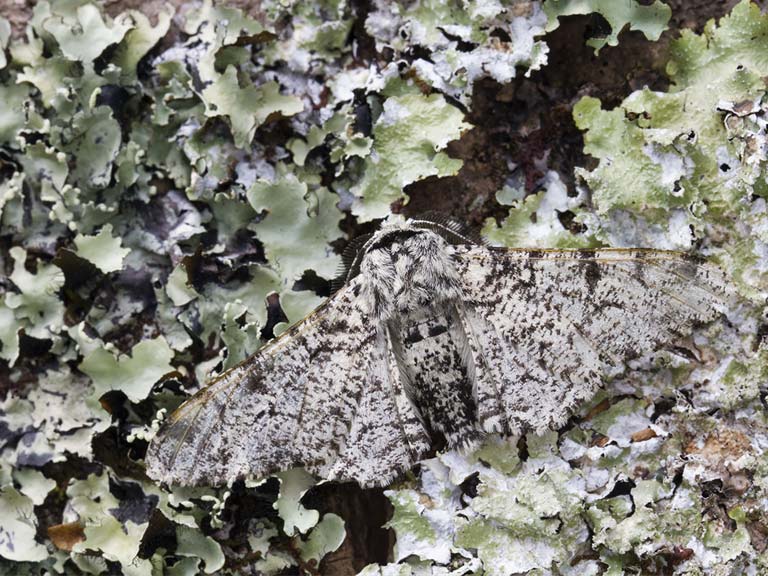
The allele frequency for this coloration gene varies in different populations and has been observed to change over time.
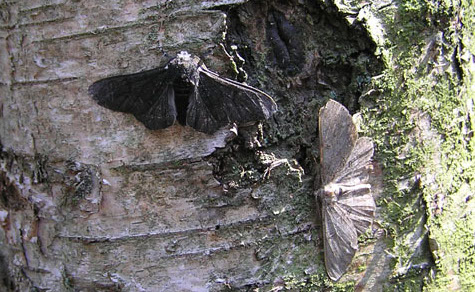
In the mid-1800s, in moth populations that lived in forests where tree trunks were covered with white-colored lichens, dark moths were rare (2% of the population), with 98% of the moths having the typical peppered form. Why? It was all about natural selection. Birds eat moths. Birds more frequently eat moths that are easier to see. The peppered moth, when it’s not flying, rests on the trunks of trees. In the photo on the left, you can see what the light-colored form of the peppered moth looks like when it’s resting on a lichen-covered tree trunk. On the right, you can see what a dark-colored moth looks like on a light-colored tree. If you were a bird, which color moth would be easier for you to find?
Once you know the frequency of each phenotype, you can use the Hardy-Weinberg formula to calculate the allele frequencies. From what you read above, you know that the light-colored form is recessive and that the frequency of moths with the light-colored phenotype was 98%.
Try to solve for the frequency of the dominant and recessive alleles. Then use the cards below to confirm your work, and to see how these moths evolved over time (in other words, even if you know the answer, do the quiz).
[qwiz style=”width: 600px !important; min-height: 450px !important;” qrecord_id=”sciencemusicvideosMeister1961-Peppered Moth Hardy Weinberg Challenge (v2.0)”]
[h]Peppered Moth Hardy-Weinberg Challenge
[q] STEP 1: The frequency of the recessive phenotype is 0.98. So put 0.98 in the lower right part of the Punnett square.
| A | a | |
| A | AA | Aa |
| a | Aa | aa (0.98) |
Now, take the square root of 0.98 to get the frequency of allele “a.” Use the formula p + q = 1 to get the frequency of the dominant alleles. The solution is on the next card.
[q]
| A (.011) | a (.989) | |
| A | AA | Aa |
| a | Aa | aa (0.98) |
The frequency of the dominant allele (p) is 0.011. The frequency of the recessive allele (q) is 0.989.
[q]Changes in the moths’ environment led these allele frequencies to change. This was first observed in Northern England in the mid-1800s. As the Industrial Revolution led to the combustion of coal to fuel factories, soot and smoke poured into the atmosphere. The soot killed the lichens and covered the tree trunks. By 1895, 95% of the moths were dark-colored. Why? What had been a favored phenotype (light coloration) now became a disadvantage, as birds could easily see the light-colored moths against the dark-colored trees. Conversely, the dark-colored phenotype now conferred a survival advantage.
Calculate the new allele frequencies.
[q] STEP 1: The frequency of the recessive phenotype is 0.05. We know this because the frequency of dark-colored moths is 95%. So put 0.05 in the lower right part of the Punnett square.
| A | a | |
| A | AA | Aa |
| a | Aa | aa (0.05) |
Now, take the square root of 0.05 to get the frequency of allele “a.” Use the formula p + q = 1 to get the frequency of the dominant allele. The solution is on the next card.
[q]
| A (.78) | a (.22) | |
| A | AA | Aa |
| a | Aa | aa (0.05) |
The frequency of the dominant allele (p) is 0.78. The frequency of the recessive allele (q) is 0.22.
[x]
[/qwiz]
While the evolution of the peppered moth has been widely studied, the actual gene responsible for the moth’s color change was only recently discovered. You can read about it here (the link opens in a new browser tab).
Here’s a musical explanation of Peppered Moth evolution. Enjoy!
4. Natural Selection Case Study # 2: The Rock Pocket Mouse
In the southwest of the United States, the rock pocket mouse (Chaetodipus intermedius) lives on two types of landscapes: dark-colored lava, and lighter-colored rock and sand.
|
|
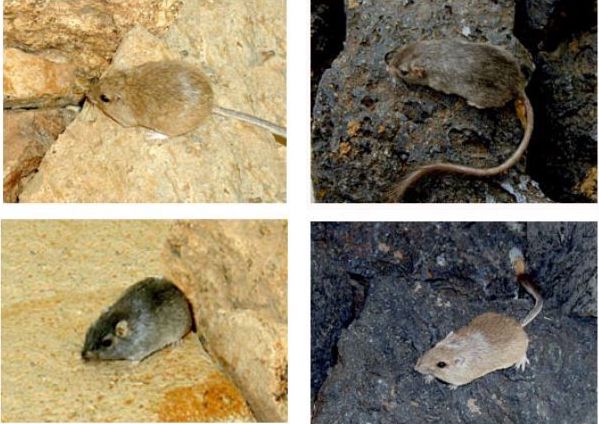
You can think of the light-colored landscape as the “default” landscape: it’s the landscape that has persisted in that area for millions of years. In that light-colored landscape, the favored phenotype for rock pocket mice was light brown-colored fur. Why? In the same way that birds selected the peppered moth for effective camouflage, birds (mostly owls and hawks) selected the rock pocket mice in the light-colored areas for fur that matched their environment.
Within the past few thousand years, volcanic activity deposited flows of dark-colored lava into this landscape. When mice from the light-colored areas wandered onto these lava flows, they were easily seen by owls, hawks, and other predators. However, a small percentage of the mice born each year are mutants. The mutation is in a gene called MC1R. A mutant allele leads to a much darker fur color. Those mutant mice, on the dark lava flows, had a favored phenotype. This increased their chance of surviving and reproducing and made colonization of the dark lava flows possible.
Interestingly, the specific mutation that caused the dark phenotype varies from area to area. In other words, the evolution of dark pigmentation in different dark-colored areas in different populations of rock pocket mice is an example of parallel evolution. This is similar to what you learned about in Unit 6, where different populations of stickleback fish living in freshwater evolved a similar phenotype (no pelvic spine) but the genetic mutation that caused this phenotype was different in each population.
5. Natural Selection can be Directional, Stabilizing, or Disruptive
The type of natural selection described above moves the average phenotype in a population in one consistent direction. In the case of the peppered moth, the darkening of tree trunks set the stage for birds who ate moths to select for moths with darker coloration. Over time, as pollution continued to darken the forests, the number of moths with the dark phenotype increased, and the number of moths with a lighter phenotype decreased. This, in turn, changed the underlying allele frequencies.
This type of natural selection is called directional selection. If you were to graph the frequency of some trait (size, color, enzyme activity, etc.), it would look like what’s shown below. The average moves in a specific direction. For example, as the giraffe was evolving, the average length of the neck and legs was increasing. Or, in the case of the peppered moth, the average amount of pigment increased. For blue whales, the directional change involved increasing size. For jackrabbits, it involved heat tolerance. For rattlesnakes, it’s venom toxicity. For cheetahs, it’s running speed.
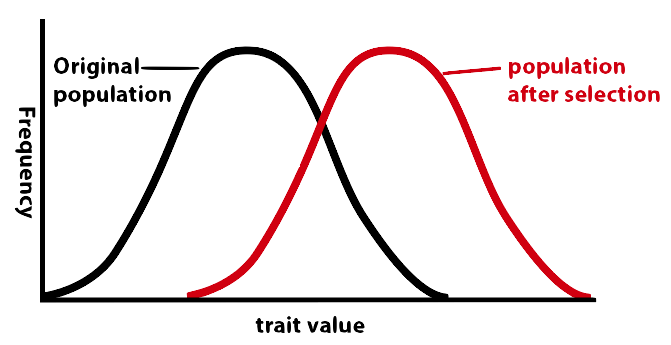
Selection doesn’t have to push in one direction. There can also be selection for the average, and away from the extremes. This is called stabilizing selection. When graphed, it looks like this.
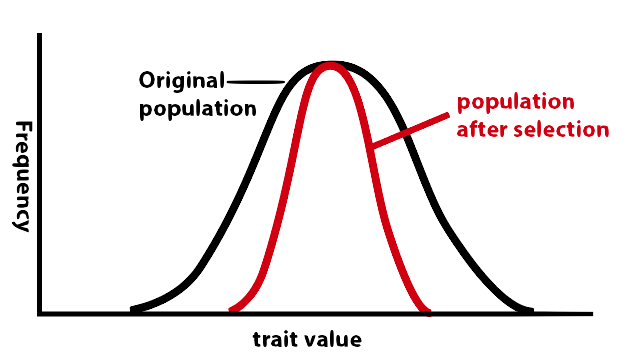
Think about the birth weight of babies. Babies that are too small have various problems that lower their survival rates. But babies that are too large (think back to the times before Cesarian births could be safely and successfully performed) can be difficult for their mothers to deliver, also lowering their survival rates. So, if the trait is birthweight, then nature is selecting against both birthweights that are too low and those that are too high. The result is stabilization around a mean (which in babies of European descent is about 3.5 kilograms (7.7 lbs), with all but 5% of babies born between 2.5 and 5 kilograms).Wikipedia
Finally, there can be selection against the mean, and for the extremes. This type of selection is said to play an important role in dividing up gene pools as a prelude to speciation. When graphed, disruptive selection looks like this:
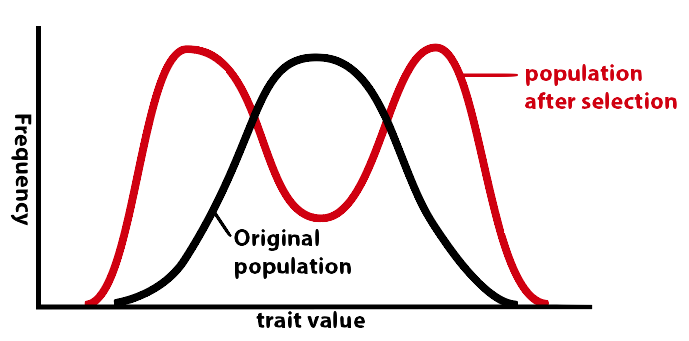
Got it? The key ideas from this section are
- The presence of harmful or beneficial changes is a violation of one of the key Hardy-Weinberg principles and results in changes in allele frequencies.
- During natural selection, the environment selects for or against certain phenotypes.
- If a phenotype is selected for, then the individuals with that phenotype will survive and reproduce at higher rates. The alleles that code for that phenotype will increase in frequency in that gene pool.
- If a phenotype is selected against, the individuals with the phenotype will survive at lower rates. The alleles that code for that phenotype will decrease in frequency in that gene pool.
- Selection comes in three varieties
- Directional selection selects for one extreme, and against the other. This moves the average phenotype within a population in one direction.
- Stabilizing selection selects against both extremes, and for the mean. This narrows the range of variation within a population.
- Disruptive selection selects against the mean, and for the extremes. This produces a bimodal distribution of phenotypes (like the hump of an Asian camel).
6. Quiz: Natural Selection in Gene Pools
[qwiz style=”width: 520px; border: 3px solid black;” qrecord_id=”sciencemusicvideosMeister1961-Natural Selection in Gene Pools (v2.0)”]
[h]Natural Selection in Gene Pools
[q]When you’re looking at an organism, you’re directly looking at its
[c]IGdlbm90eXBl[Qq]
[c]IHBoZW5v dHlwZQ==[Qq]
[f]IE5vLiBUaGUgZ2Vub3R5cGUgaXMgdGhlIHVuZGVybHlpbmcgZ2VuZXMuIFdoYXQgeW91IHNlZSB3aGVuIHlvdSBsb29rIGF0IGFuIG9yZ2FuaXNtIGlzIHRoZSBleHByZXNzaW9uIG9mIHRob3NlIGdlbmVzLg==[Qq]
[f]IENvcnJlY3QuIFdoZW4geW91IGxvb2sgYXQgYW4gb3JnYW5pc20sIHlvdeKAmXJlIGxvb2tpbmcgYXQgaXRzIHBoZW5vdHlwZS4=[Qq]
[q]Natural selection acts on an organism’s
[c]IGdlbm90eXBl[Qq]
[c]IHBoZW5v dHlwZQ==[Qq]
[f]IE5vLiBUaGUgZ2Vub3R5cGUgaXMgdGhlIHVuZGVybHlpbmcgZ2VuZXMuIE5hdHVyYWwgc2VsZWN0aW9uICh0aGUgZW52aXJvbm1lbnQpIGNhbuKAmXQgc2VlIHRoZSB1bmRlcmx5aW5nIGdlbmVzLiBJdCBjYW4gb25seSBzZWUgdGhlIGV4cHJlc3Npb24gb2YgdGhvc2UgZ2VuZXMu[Qq]
[f]IEV4YWN0bHkuIE5hdHVyYWwgc2VsZWN0aW9uICh0aGUgZW52aXJvbm1lbnQpIGNhbiBvbmx5IGFjdCB1cG9uIGFuIG9yZ2FuaXNt4oCZcyA=cGhlbm90eXBlLg==
Cg==[Qq]
[q]What evolves? Populations or individuals?
[c]IHBvcHVs YXRpb25z[Qq]
[c]IGluZGl2aWR1YWxz[Qq]
[f]IFllcy4gT25lIHdheSB0byBsb29rIGF0IGV2b2x1dGlvbiBpcyBhcyBhIHNoaWZ0IGluIHRoZSBhbGxlbGUgZnJlcXVlbmNpZXMgaW4gYSBwb3B1bGF0aW9u4oCZcyBnZW5lIHBvb2wuIEluZGl2aWR1YWxzIGdldCBzZWxlY3RlZCB0byBzdXJ2aXZlIGFuZCByZXByb2R1Y2UuIFBvcHVsYXRpb25zIGV2b2x2ZS4=[Qq]
[f]IE5vLiBPbmUgd2F5IHRvIGxvb2sgYXQgZXZvbHV0aW9uIGlzIGFzIGEgc2hpZnQgaW4gdGhlIGFsbGVsZSBmcmVxdWVuY2llcyBpbiBwb3B1bGF0aW9u4oCZcyBnZW5lIHBvb2wuIEluZGl2aWR1YWxzIGdldCBzZWxlY3RlZCB0byBzdXJ2aXZlIGFuZCByZXByb2R1Y2UuIFdoYXQgZXZvbHZlcz8=[Qq]
[q]In the rock pocket mouse, allele “b” codes for light coloration. Allele “B” codes for darker coloration. This is shown in the table below. In a desert environment with light-colored sand, what would be selected?
[c]IHRoZSBCQiBvciBCYiBnZW5vdHlwZXM=[Qq]
[c]IGRhcmsgZnVy[Qq]
[c]IHRoZSBiYiBnZW5vdHlwZQ==[Qq]
[c]IGxpZ2h0 IGZ1cg==[Qq]
[f]IE5vLiBUaGUgZW52aXJvbm1lbnQgZG9lc27igJl0IHNlbGVjdCBnZW5vdHlwZXMuIE5leHQgdGltZSwgY2hvb3NlIGEgcGhlbm90eXBlLg==[Qq]
[f]IE5vLiBJbiBhIGxpZ2h0LWNvbG9yZWQgZW52aXJvbm1lbnQsIGEgbW91c2Ugd2l0aCBkYXJrIGZ1ciB3b3VsZCBiZSBlYXNpbHkgc2VlbiBieSBwcmVkYXRvcnMuIFRoaW5rIG9mIHNlbGVjdGlvbiBhcyB0aGUgcm9sZSBvZiB0aGUgYnJlZWRlciwgd2hvIHNlbGVjdHMgd2hpY2ggaW5kaXZpZHVhbHMgZ2V0IHRvIHN1cnZpdmUgYW5kIHJlcHJvZHVjZS4gV2hhdCBhcmUgdGhlIG93bHMgc2VsZWN0aW5nIGZvciByZXByb2R1Y3Rpb24/[Qq]
[f]IE5vLCBidXQgeW91IHNlZW0gdG8gYmUgdGhpbmtpbmcgYWJvdXQgdGhpcyBpbiBhIHNtYXJ0IHdheS4gSnVzdCByZW1lbWJlciB0aGF0IGl04oCZcyB0aGUgcGhlbm90eXBlLCBub3QgdGhlIGdlbm90eXBlLCB0aGF0IGdldHMgc2VsZWN0ZWQu[Qq]
[f]IEV4YWN0bHkuIE1pY2Ugd2l0aCBsaWdodCBmdXIgd2lsbCBiZSBiZXR0ZXIgY2Ftb3VmbGFnZWQuIEFzIGEgcmVzdWx0LCB0aGF0IHRyYWl0IHdpbGwgYmUgc2VsZWN0ZWQgZm9yIHN1cnZpdmFsIGFuZCByZXByb2R1Y3Rpb24gYnkgdGhlIGVudmlyb25tZW50Lg==[Qq]
[q]In the rock pocket mouse, allele “b” codes for light coloration. Allele “B” codes for darker coloration, as is shown in the table below. If a population of mice is living on dark, volcanic rock, which of the following would most likely be correct?
[c]IE93bHMgd2lsbCBkaXJlY3RseSBzZWxlY3QgYWdhaW5zdCBkYXJrIGZ1ci4=[Qq]
[c]IE93bHMgd2lsbCBkaXJlY3RseSBzZWxlY3QgYWdhaW5zdCB0aGUg4oCcQuKAnSBhbGxlbGUu4oCd[Qq]
[c]IE93bHMgd2lsbCBkaXJlY3RseSBzZWxlY3QgYWdhaW5zdCB0aGUg4oCcYmLigJ0gZ2Vub3R5cGUu[Qq]
[c]IE93bHMgd2lsbCBkaXJlY3RseSBzZW xlY3QgYWdhaW5zdCBsaWdodCBmdXIu[Qq]
[f]IE5vLiBJbiBhIGRhcmstY29sb3JlZCBlbnZpcm9ubWVudCwgdGhlIG93bHMgd2lsbCBiZSBjYXRjaGluZyBhbmQgZWF0aW5nIG1vcmUgb2YgdGhlIG1pY2Ugd2l0aCBsaWdodCBmdXIuIEluIG90aGVyIHdvcmRzLCBwcmVkYXRpb24gYnkgb3dscyByZXN1bHRzIGluIHNlbGVjdGlvbiBGT1IgdGhlIGRhcmstZnVycmVkIHBoZW5vdHlwZS4gVGhpcyBpcyBiZWNhdXNlIHRoZSBkYXJrLWZ1cnJlZCBtaWNlIHdpbGwgYmUgZWF0ZW4gbGVzcywgYW5kIHdpbGwgc3Vydml2ZSBtb3JlLCBlbmFibGluZyB0aGVtIHRvIHJlcHJvZHVjZS4=[Qq]
[f]IE5vLiBBIHByZWRhdG9yIGlzIG9ubHkgZ29pbmcgdG8gc2VlIHRoZSBwaGVub3R5cGUsIG5vdCB0aGUgZ2Vub3R5cGUuIFRoZSBvd2xzIGNhbuKAmXQgc2VlIHRoZSDigJhC4oCZIGFsbGVsZS4gV2hhdCBwaGVub3R5cGUgY2FuIHRoZXkgc2VlPw==[Qq]
[f]IE5vLiBBIHByZWRhdG9yIGlzIG9ubHkgZ29pbmcgdG8gc2VlIHRoZSBwaGVub3R5cGUsIG5vdCB0aGUgZ2Vub3R5cGUuIFRoZSBvd2xzIGNhbuKAmXQgc2VlIGEgZ2Vub3R5cGUuIFdoYXQgcGhlbm90eXBlIGNhbiB0aGV5IHNlZT8gVGhhdOKAmXMgdGhlIHBoZW5vdHlwZSB0aGV54oCZbGwgYmUgc2VsZWN0aW5nIGFnYWluc3Qu[Qq]
[f]IENvcnJlY3QuIEluIGEgZGFyay1jb2xvcmVkIGVudmlyb25tZW50LCBvd2xzIHdpbGwgc2VlIGFuZCBlYXQgbWljZSB3aXRoIGxpZ2h0IGZ1ci4gSW4gb3RoZXIgd29yZHMsIHRoZSBvd2xzIGFyZSBzZWxlY3RpbmcgYWdhaW5zdCB0aGUgbGlnaHQtZnVycmVkIHBoZW5vdHlwZS4=[Qq]
[q]Natural selection changes
[c]IFBoZW5vdHlwZXMgaW4gaW5kaXZpZHVhbHM=[Qq]
[c]IEdlbm90eXBlcyBpbiBpbmRpdmlkdWFscw==[Qq]
[c]IEFsbGVsZSBmcmVxdWVuY2ll cyBpbiBwb3B1bGF0aW9ucw==[Qq]
[f]IE5vLiBOYXR1cmUgY2FuIHNlbGVjdCBhIHBoZW5vdHlwZSBmb3Igc3Vydml2YWwgYW5kIHJlcHJvZHVjdGlvbi4gQnV0IHRoZSBzZWxlY3Rpb24gcHJvY2VzcyBkb2VzbuKAmXQgY2hhbmdlIHRoYXQgcGhlbm90eXBlLiBPdmVyIHRpbWUsIHdoYXQgY2hhbmdlcz8=[Qq]
[f]IE5vLiBUaGUgZW52aXJvbm1lbnQgZG9lc27igJl0IGNoYW5nZSBhbiBvcmdhbmlzbeKAmXMgZ2Vub3R5cGUuIEV2b2x1dGlvbmFyeSBjaGFuZ2UgZG9lc27igJl0IGhhcHBlbiBvbiBhbiBpbmRpdmlkdWFsIGxldmVsLiBXaGF04oCZcyB0aGUgbGV2ZWwgb2YgYmlvbG9naWNhbCBvcmdhbml6YXRpb24gdGhhdOKAmXMgbGFyZ2VyIHRoYW4gdGhlIGluZGl2aWR1YWwgKGFuZCB0aGUgbGV2ZWwgb24gd2hpY2ggZXZvbHV0aW9uYXJ5IGNoYW5nZSBvY2N1cnM/KQ==[Qq]
[f]IENvcnJlY3QuIEJ5IHNlbGVjdGluZyBwaGVub3R5cGVzLCBuYXR1cmFsIHNlbGVjdGlvbiBjaGFuZ2VzIHRoZSBhbGxlbGUgZnJlcXVlbmNpZXMgb2YgYSBwb3B1bGF0aW9uLg==[Qq]
[q]In a gene pool, a dominant allele has a frequency of 0.2 (20%) and the recessive allele has a frequency of 0.8 (80%). If neither allele is for a phenotype that is being acted upon by the environment, then after 10 generations, you would expect that
[c]IHRoZSBhbGxlbGUgZnJlcXVlbmNpZXMgd2 lsbCByZW1haW4gYWJvdXQgdGhlIHNhbWUu[Qq]
[c]IFRoZSByZWNlc3NpdmUgYWxsZWxlLCBiZWNhdXNlIGl04oCZcyBhbHJlYWR5IHNvIG11Y2ggbW9yZSBjb21tb24sIHdpbGwgYmVjb21lIGZpeGVkIGF0IDEuMCBvciAxMDAl[Qq]
[c]IFRoZSBkb21pbmFudCBhbGxlbGUsIGJlY2F1c2UgaXQgZG9taW5hdGVzIHRoZSByZWNlc3NpdmUgYWxsZWxlLCB3aWxsIHN0ZWFkaWx5IGluY3JlYXNlIGluIGZyZXF1ZW5jeS4=[Qq]
[f]IFllcy4gVW5sZXNzIHNvbWUgZm9yY2UgbGlrZSBuYXR1cmFsIHNlbGVjdGlvbiBpcyBhY3RpbmcgdXBvbiBhIHBvcHVsYXRpb24sIHRoZSBmcmVxdWVuY3kgb2YgdGhlIGFsbGVsZXMgdGhhdCBtYWtlIHVwIGl0cyBnZW5lIHBvb2wgc2hvdWxkIHJlbWFpbiBhYm91dCB0aGUgc2FtZS4=[Qq]
[f]IE5vLiBUaGVyZeKAmXMgbm8gYnVpbHQtaW4gdGVuZGVuY3kgZm9yIGZyZXF1ZW50IGFsbGVsZXMgdG8gYmVjb21lIG1vcmUgZnJlcXVlbnQuIFVubGVzcyBzb21lIGZvcmNlIGxpa2UgbmF0dXJhbCBzZWxlY3Rpb24gaXMgYWN0aW5nIHVwb24gYSBwb3B1bGF0aW9uLCB0aGUgZnJlcXVlbmN5IG9mIHRoZSBhbGxlbGVzIHRoYXQgbWFrZSB1cCBpdHMgZ2VuZSBwb29sIHNob3VsZCByZW1haW4gYWJvdXQgdGhlIHNhbWUu[Qq]
[f]IE5vLiBVbmxlc3Mgc29tZSBmb3JjZSBsaWtlIG5hdHVyYWwgc2VsZWN0aW9uIGlzIGFjdGluZyB1cG9uIGEgcG9wdWxhdGlvbiwgdGhlIGZyZXF1ZW5jeSBvZiB0aGUgYWxsZWxlcyB0aGF0IG1ha2UgdXAgaXRzIGdlbmUgcG9vbCBzaG91bGQgcmVtYWluIGFib3V0IHRoZSBzYW1lLiBEb21pbmFudCBhbGxlbGVzIGFyZSBvbmx5IGRvbWluYW50IGluc29mYXIgYXMgdGhleSBjYW4gbWFzayBhIHJlY2Vzc2l2ZSBhbGxlbGUgd2hlbiBib3RoIGFwcGVhciBpbiB0aGUgc2FtZSBpbmRpdmlkdWFsLiBPbiBhIHBvcHVsYXRpb24gbGV2ZWwsIHRoZXJl4oCZcyBub3RoaW5nIGFib3V0IGRvbWluYW50IGFsbGVsZXMgdGhhdCB3aWxsIG1ha2UgdGhlbSBpbmNyZWFzZSBpbiBmcmVxdWVuY3ku[Qq]
[/qwiz]
7. Why Harmful Alleles Persist
Based on what you read above, it’s reasonable to think that because harmful alleles produce phenotypes that make individuals less fit, they should disappear from any gene pool. But that tends not to be the case. Here’s why
7a. The Persistence of Harmful Recessive Alleles
[qwiz qrecord_id=”sciencemusicvideosMeister1961-Harmful Recessive Alleles in Gene Pools (v2.0)”]
[h]Interactive Reading: Harmful Recessive Alleles in Gene Pools
[q labels = “top”]
To begin with, why are most harmful alleles recessive? One way to think about this is that recessive alleles are often ___________ versions of a functioning allele. You can see this in the case of Tay-Sachs disease, a lethal disease of the brain. A baby born with Tay-Sachs disease begins life normally. But soon, he or she experiences ongoing deterioration of nerve cells and loss of mental and physical abilities. There’s no cure or treatment.
The allele that causes Tay-Sachs is recessive. If you inherit _____ of these alleles, you’re unable to break down a specific kind of lipid, which builds up in the brain, destroying nerve cells. In other words, the allele codes for a non-functioning _________. The dominant allele codes for a __________ version of the enzyme: if you inherit one version of the functioning allele, you’ll be able to produce the enzyme, and ________ the disease. For more about Tay-Sachs, follow this link to a Wikipedia article (which will open in a new tab)
[l]avoid
[fx] No, that’s not correct. Please try again.
[f*] Correct!
[l]enzyme
[fx] No. Please try again.
[f*] Great!
[l]broken
[fx] No. Please try again.
[f*] Great!
[l]two
[fx] No. Please try again.
[f*] Great!
[l]working
[fx] No, that’s not correct. Please try again.
[f*] Excellent!
[q]In the United States, Tay-Sachs is most common in Jews of Eastern European descent, where it occurs in 1 in every 3500 births. In the larger American population, the frequency is 1 in 320,000 births. Why wouldn’t such a harmful genetic condition simply disappear?
[c]U2hvdyB0aG UgYW5zd2Vy[Qq]
[f]T25lIHJlYXNvbiBpcyB0aGF0IGxldGhhbCByZWNlc3NpdmUgYWxsZWxlcyBjYW4g4oCcaGlkZSBvdXTigJ0gaW4gaGV0ZXJvenlnb3Rlcywgd2hvIHdpbGwgcG9zc2VzcyBvbmx5IG9uZSBjb3B5IG9mIHRoZSByZWNlc3NpdmUgYWxsZWxlLiBZb3UgY2FuIHByb3ZlIHRoaXMgdG8geW91cnNlbGYgb24gdGhlIG5leHQgY2FyZCBieSB3b3JraW5nIHRocm91Z2ggYSBQdW5uZXR0IFNxdWFyZS4=[Qq]
[q]The allele Tay-Sachs (t) is recessive. We’ll use “T” to represent the allele for the normal enzyme. What will happen if two people who are carriers for the alleles have children?
Step 1: determine the genotypes of the parents
Parent 1) : ___ ___
Parent 2) : ___ ___
Steps 2-4: Complete the Punnett square.
| Parent 2 | |||
| __ | __ | ||
| Parent 1 | __ | ___ ___ | ___ ___ |
| __ | ___ ___ | ___ ___ | |
Step 5: Genotype ratio: ______ TT: _____Tt: _____tt
Step 6: Phenotype ratio: ______ Normal: _____Tay-sachs
[l]T
[fx] No, that’s not correct. Please try again.
[f*] Correct!
[l]t
[fx] No, that’s not correct. Please try again.
[f*] Great!
[l]0%
[fx] No, that’s not correct. Please try again.
[f*] Correct!
[l]25%
[fx] No, that’s not correct. Please try again.
[f*] Excellent!
[l]50%
[fx] No. Please try again.
[f*] Good!
[l]75%
[fx] No, that’s not correct. Please try again.
[f*] Great!
[l]100%
[fx] No. Please try again.
[f*] Great!
[q]Because Tay Sachs is caused by a recessive allele, you can only have the condition if you inherit two copies (tt). Each of your parents would have to be a heterozygote (Tt). With each child they produced, there would be a one in four chance that this child would inherit two recessive alleles and have the tt genotype.
While the loss of ¼ of their offspring from the disease certainly reduces the number of alleles that get passed on, you can see why the allele doesn’t disappear. Half of the children of parents who are heterozygotes will also be heterozygotes (Tt).
In terms of the gene pool, what’s the result of this?
[c]U2hvdyB0aGUg YW5zd2VyLg==[Qq]
[f]VGhlIGFsbGVsZSBwZXJzaXN0cyBpbiB0aGUgZ2VuZSBwb29sLg==[Qq]
[q]Just to make sure that you’re getting this, identify the genotypes of the individuals in the pedigree on the next page, which shows the inheritance of Tay-Sachs disease.
[q labels = “top”]In this pedigree for Tay-Sachs disease, carriers (heterozygotes) are shaded-in half way.
[l]TT
[fx] No, that’s not correct. Please try again.
[f*] Good!
[l]Tt
[fx] No, that’s not correct. Please try again.
[f*] Great!
[l]tt
[fx] No, that’s not correct. Please try again.
[f*] Good!
[/qwiz]
The takeaway message: this harmful allele persists in gene pools because it can hide out in heterozygotes.
7b. The persistence of harmful dominant alleles
There are, of course, harmful dominant alleles. We discussed two of these, achondroplasic dwarfism and Huntington’s disease, in this tutorial in AP Bio Unit 5. Because harmful dominant alleles always have an immediate effect on the phenotype, they tend to be strongly selected against. However, even harmful dominant alleles can persist in a population’s gene pool. Here’s why.
Let’s look at achondroplasia first. For one thing, while it’s harmful, it’s not lethal. People with achondroplasia not only survive to adulthood: they can also reproduce. When they do, they have a 1 in 2 chance of passing on the allele to the next generation, keeping the allele in the gene pool (achondroplasiacs are never homozygous: two alleles are a fatal combination). In addition, achondroplasia can emerge as a spontaneous mutation: about 80% of achondroplasiacs are born to parents who are of normal height. If you’re interested, you can read more about achondroplasia at the National Library of Medicine.

Huntington’s disease persists in the population for a different reason. Its key symptoms –including loss of control of movement, difficulty thinking clearly, and depression – don’t set in until middle age. Until recently, when the gene was identified, people usually only learned that they had Huntington’s after they had already had children (and, in fact, often not until their children were adults). Because of that, possessing the Huntington’s allele never reduced one’s chance of producing offspring, and of passing on the Huntington’s allele.
The story of the famous American folksinger Woody Guthrie is an example. Guthrie, who wrote classic songs like “This Land is Your Land” and “So Long, It’s Been Good to Know You,” was diagnosed with Huntington’s disease when he was 40. By then, he had already married and fathered several of his eight children, two of which died of Huntington’s in their early 40s.
8. The Persistence of Harmful Alleles: Checking Understanding
[qwiz qrecord_id=”sciencemusicvideosMeister1961-Why Harmful Alleles Persist (v2.0)”]
[h]Why harmful alleles persist in gene pools
[i]This quiz assesses what you learned above. It’s also a review of some of the genetics you learned in Unit 5.
[q ]True or false: because of natural selection, harmful alleles will inevitably disappear from a gene pool.
[c]IFRydWU=[Qq]
[c]IEZh bHNl[Qq]
[f]IE5vLiBXaGlsZSBoYXJtZnVsIHJlY2Vzc2l2ZSBhbGxlbGVzIHdpbGwgYmUgc2VsZWN0ZWQgYWdhaW5zdCwgaXTigJlzIGFsbW9zdCBpbXBvc3NpYmxlIGZvciB0aGVtIHRvIGNvbXBsZXRlbHkgZGlzYXBwZWFyIGZyb20gYSBnZW5lIHBvb2wuIFRoYXTigJlzIGJlY2F1c2UgbmF0dXJhbCBzZWxlY3Rpb24gY2FuIG9ubHkg4oCYc2Vl4oCZIHRoZSBwaGVub3R5cGUsIG5vdCB0aGUgZ2Vub3R5cGUuIFJlY2Vzc2l2ZSBhbGxlbGVzIGNhbiBoaWRlIG91dCBpbiBoZXRlcm96eWdvdGVzLCBhbGxvd2luZyB0aGVtIHRvIHBlcnNpc3QgaW4gZ2VuZSBwb29scy4gQW5kLCBhcyB3ZSYjODIxNzt2ZSByZWFkIGFib3ZlLCB0aGVyZSBhcmUgYSB2YXJpZXR5IG9mIHJlYXNvbnMgd2h5IGhhcm1mdWwgZG9taW5hbnQgYWxsZWxlcyBjYW4gcGVyc2lzdCBpbiBnZW5lIHBvb2xzIChpbmNsdWRpbmcgc2V0dGluZyBpbiBsYXRlciBpbiBsaWZlLCBhbmQgbm90IHByZXZlbnRpbmcgaW5kaXZpZHVhbHMgd2l0aCB0aGVzZSBhbGxlbGVzIGZyb20gcmVwcm9kdWNpbmcpLg==[Qq]
[f]IENvcnJlY3QuIEJlY2F1c2UgcmVjZXNzaXZlIGFsbGVsZXMgY2FuIGhpZGUgb3V0IGluIGhldGVyb3p5Z290ZXMsIHRoZXkgY2FuIHBlcnNpc3QgaW4gZ2VuZSBwb29scywgcHJhY3RpY2FsbHkgaW5kZWZpbml0ZWx5LsKgQW5kLCBhcyB3ZSYjODIxNzt2ZSByZWFkIGFib3ZlLCB0aGVyZSBhcmUgYSB2YXJpZXR5IG9mIHJlYXNvbnMgd2h5IGhhcm1mdWwgZG9taW5hbnQgYWxsZWxlcyBjYW4gcGVyc2lzdCBpbiBnZW5lIHBvb2xzIChpbmNsdWRpbmcgc2V0dGluZyBpbiBsYXRlciBpbiBsaWZlLCBhbmQgbm90IHByZXZlbnRpbmcgaW5kaXZpZHVhbHMgd2l0aCB0aGVzZSBhbGxlbGVzIGZyb20gcmVwcm9kdWNpbmcpLg==
Cg==[Qq]
[q]Which type of genotype allows for recessive alleles to hide out, shielded from natural selection?
[c]IGhvbW96eWdvdXMgcmVjZXNzaXZlcw==[Qq]
[c]IGhldGVyb3 p5Z290ZXM=[Qq]
[c]IGhvbW96eWdvdXMgZG9taW5hbnRz[Qq]
[f]IE5vLiBIb21venlnb3VzIHJlY2Vzc2l2ZXMgaGF2ZSB0d28gY29waWVzIG9mIHRoZSByZWNlc3NpdmUgYWxsZWxlLiBXaGF0ZXZlciBwaGVub3R5cGUgdGhhdCBhbGxlbGUgaXMgY29ubmVjdGVkIHdpdGggd2lsbCBiZSBmdWxseSBleHBvc2VkIHRvIG5hdHVyYWwgc2VsZWN0aW9uLiBOZXh0IHRpbWUsIHRoaW5rIGFib3V0IHdoaWNoIGtpbmQgb2YgaW5kaXZpZHVhbCBjb3VsZCBwb3NzZXNzIGEgcmVjZXNzaXZlIGFsbGVsZSwgYnV0IG5vdCBleHByZXNzIHRoYXQgYWxsZWxlIGluIGhpcyBvciBoZXIgcGhlbm90eXBlLg==[Qq]
[f]IENvcnJlY3QuIEluIGhldGVyb3p5Z290ZXMsIGEgcmVjZXNzaXZlIGFsbGVsZSB3aWxsIGJlIG1hc2tlZCBieSB0aGUgZG9taW5hbnQgYWxsZWxlLiBUaGlzIGFsbG93cyB0aGUgcmVjZXNzaXZlIGFsbGVsZSB0byBoaWRlIG91dCBpbiB0aGUgaGV0ZXJvenlnb3RlLCBzaGllbGRpbmcgaXQgZnJvbSBuYXR1cmFsIHNlbGVjdGlvbi4=[Qq]
[f]IE5vLiBIb21venlnb3VzIGRvbWluYW50cyBkb27igJl0IGNhcnJ5IGFueSBjb3BpZXMgb2YgdGhlIHJlY2Vzc2l2ZSBhbGxlbGUuIE5leHQgdGltZSwgdGhpbmsgYWJvdXQgd2hpY2gga2luZCBvZiBpbmRpdmlkdWFsIGNvdWxkIHBvc3Nlc3MgYSByZWNlc3NpdmUgYWxsZWxlLCBidXQgbm90IGV4cHJlc3MgdGhhdCBhbGxlbGUgaW4gaGlzIG9yIGhlciBwaGVub3R5cGUu
Cg==[Qq]
[q]In the Punnett square below, ‘t’ represents the allele for Tay-Sachs disease, and ‘T’ is the normal allele. Which square represents the genotype of an individual who is a carrier for Tay-Sachs?
[c]IFNxdWFyZSAx[Qq]
[c]IFNxdW FyZSAy[Qq]
[c]IFNxdWFyZSA0[Qq]
[f]IE5vLiBTcXVhcmUgMSBzaG93cyBhbiBpbmRpdmlkdWFsIHdobyBoYXMgdHdvIOKAmG5vcm1hbOKAmSBhbGxlbGVzLiBBIGNhcnJpZXIgaXMgc29tZW9uZSB3aXRoIGEgbm9ybWFsIHBoZW5vdHlwZSwgYnV0IHdobyBwb3NzZXNzZXMgdGhlIGFsbGVsZS4=[Qq]
[f]IENvcnJlY3QuIFNxdWFyZSAyIHNob3dzIGFuIGluZGl2aWR1YWwgd2hvIGlzIGEgaGV0ZXJvenlnb3RlLiBIZSBvciBzaGUgcG9zc2Vzc2VzIHRoZSBhbGxlbGUgYnV0IHdvbuKAmXQgc2hvdyBpdCBpbiBoaXMgb3IgaGVyIHBoZW5vdHlwZS4=[Qq]
[f]IE5vLiBTcXVhcmUgNCBzaG93cyB0aGUgZ2Vub3R5cGUgb2YgYW4gaW5kaXZpZHVhbCB3aG8gaXMgaG9tb3p5Z291cyByZWNlc3NpdmUuIFdoaWxlIHRoZXkgY2VydGFpbmx5IGNhcnJ5IHRoZSBhbGxlbGUsIHRoZXnigJlyZSBub3QgY29uc2lkZXJlZCBhIGNhcnJpZXIgaW4gdGhpcyBzcGVjaWFsIGdlbmV0aWNzIHNlbnNlIG9mIHRoZSB3b3JkLiBBIGNhcnJpZXIg4oCYY2Fycmllc+KAmSB0aGUgYWxsZWxlLCBidXQgZG9lc27igJl0IGV4cHJlc3MgaXQgaW4gaGlzIG9yIGhlciBwaGVub3R5cGUuIEJlY2F1c2UgdGhpcyBpbmRpdmlkdWFsIHdpbGwgZXhwcmVzcyB0aGUgcGhlbm90eXBlLCB0aGV54oCZcmUgbm90IGNvbnNpZGVyZWQgdG8gYmUgYSBjYXJyaWVyLg==
Cg==[Qq]
[q]in the Punnett square below, t represents the allele for Tay-Sachs disease, and T the normal allele. Which square shows the genotype of an individual who would have Tay-Sachs disease?
[c]IFNxdWFyZSAx[Qq]
[c]IFNxdWFyZSAy[Qq]
[c]IFNxdWFyZSAz[Qq]
[c]IFNxdW FyZSA0[Qq]
[f]IE5vLiBJbmRpdmlkdWFsIDEgaGFzIHR3byDigJhub3JtYWzigJkgYWxsZWxlcy4gWW914oCZZCBoYXZlIHRvIGhhdmUgdHdvIHJlY2Vzc2l2ZSBhbGxlbGVzIGluIG9yZGVyIHRvIGV4cHJlc3MgdGhlIHJlY2Vzc2l2ZSBwaGVub3R5cGUsIGFuZCBoYXZlIHRoZSBkaXNlYXNlLg==[Qq]
[f]IE5vLiBJbmRpdmlkdWFsIDIgaXMgYSBoZXRlcm96eWdvdGUuIEhlIG9yIHNoZSBwb3NzZXNzZXMgdGhlIGFsbGVsZSwgYnV0IHdvbuKAmXQgc2hvdyBpdCBpbiBoZXIgb3IgaGlzIHBoZW5vdHlwZS4gYW5kIHdvbuKAmXQgaGF2ZSB0aGUgZGlzZWFzZS4=[Qq]
[f]IE5vLiBJbmRpdmlkdWFsIDMgaXMgYSBoZXRlcm96eWdvdGUuIEhlIG9yIHNoZSBwb3NzZXNzZXMgdGhlIGFsbGVsZSwgYnV0IHdvbuKAmXQgc2hvdyBpdCBpbiBoZXIgb3IgaGlzIHBoZW5vdHlwZS4gYW5kIHdvbuKAmXQgaGF2ZSB0aGUgZGlzZWFzZS4=[Qq]
[f]IFllcy4gSW5kaXZpZHVhbCA0IGlzIGhvbW96eWdvdXMgcmVjZXNzaXZlLiBIZSBvciBzaGUgaGFzIHR3byBjb3BpZXMgb2YgdGhlIHJlY2Vzc2l2ZSBhbGxlbGUgYW5kIHdpbGwgaGF2ZSBUYXktU2FjaHMgZGlzZWFzZQ==
Cg==[Qq]
[q]If two individuals who are heterozygous for a lethal (deadly) genetic condition mate and produce offspring, what is the probability that their offspring will inherit the lethal condition?
[c]IG9uZSBp biBmb3Vy[Qq]
[c]IHR3byBpbiBmb3Vy[Qq]
[c]IHRocmVlIGluIGZvdXI=[Qq]
[c]IGZvdXIgaW4gZm91cg==[Qq]
[f]IFllcy4gSWYgeW91IGNyb3NzIHR3byBoZXRlcm96eWdvdGVzLCDigJhUdOKAmSBhbmQg4oCYVHQs4oCZIHlvdSBjYW7CoHNlZSB0aGF0IG9uZSBpbiBmb3VyIG9mIHRoZSBvZmZzcHJpbmcgd2lsbCBpbmhlcml0IHRoZSBjb25kaXRpb24u[Qq]
[f]IE5vLiBKdXN0IGV4YW1pbmUgdGhlIFB1bm5ldHQgc3F1YXJlIGFib3ZlLsKgV2hhdCBwcm9wb3J0aW9uIG9mIHRoZSBvZmZzcHJpbmcgd2lsbCBoYXZlIHRoZSDigJh0dOKAmSBnZW5vdHlwZT8=[Qq]
[f]IE5vLsKgSnVzdCBleGFtaW5lIHRoZSBQdW5uZXR0IHNxdWFyZSBhYm92ZS7CoFdoYXQgcHJvcG9ydGlvbiBvZiB0aGUgb2Zmc3ByaW5nIHdpbGwgaGF2ZSB0aGUg4oCYdHTigJkgZ2Vub3R5cGU/[Qq]
[f]IE5vLsKgSnVzdCBleGFtaW5lIHRoZSBQdW5uZXR0IHNxdWFyZSBhYm92ZS7CoFdoYXQgcHJvcG9ydGlvbiBvZiB0aGUgb2Zmc3ByaW5nIHdpbGwgaGF2ZSB0aGUg4oCYdHTigJkgZ2Vub3R5cGU/
Cg==[Qq]
[q]The pedigree chart below shows the inheritance of a lethal recessive allele. If B represents the normal allele, and ‘b’ is the recessive allele, what would be the genotype of I-1?
[c]wqBCQg==[Qq]
[c]wqBiYg==[Qq]
[c]wqBC Yg==[Qq]
[f]IE5vLiBJZiBJLTEgaGFkIHRoZSBnZW5vdHlwZSDigJhCQizigJkgdGhlbiBoZSBjb3VsZCBvbmx5IHBhc3MgYSDigJhC4oCZIGFsbGVsZSBvbiB0byBoaXMgb2Zmc3ByaW5nLiBOb25lIG9mIHRoZW0gY291bGQgaGF2ZSBpbmhlcml0ZWQgdHdvIOKAmGLigJkgYWxsZWxlcy4gU2luY2UgSUktMyBoYXMgdGhlIHJlY2Vzc2l2ZSBjb25kaXRpb24sIHNoZSBoYXMgdG8gaGF2ZSBpbmhlcml0ZWQgdHdvICYjODIyMDtiYiYjODIyMTsgYWxsZWxlcywgYW5kIHRoZXJlZm9yZSBoZXIgZmF0aGVyIGNvdWxkIG5vdCBoYXZlIGJlZW4g4oCYQkIu4oCZ[Qq]
[f]IE5vLiBUaGUgY29uZGl0aW9uIGlzIGxldGhhbCwgd2hpY2ggbWVhbnMgdGhhdCB5b3UgY2FuIGJlIGJvcm4gd2l0aCB0aGUgY29uZGl0aW9uLCBidXQgaXQgd2lsbCBraWxsIHlvdSBiZWZvcmUgeW91IGhhdmUgdGhlIGNoYW5jZSB0byByZXByb2R1Y2UgYW5kIHBhc3MgaXQgb24uIE5vIGFkdWx0cyBjYW4gYmUg4oCYYmIu4oCZ[Qq]
[f]IFllcy4gRm9yIGluZGl2aWR1YWwgSUktMyB0byBoYXZlIGluaGVyaXRlZCB0d28g4oCYYuKAmSBhbGxlbGVzLCBzaGUgaGFkIHRvIGhhdmUgaW5oZXJpdGVkIG9uZSBhbGxlbGUgZnJvbSBlYWNoIG9mIGhlciBwYXJlbnRzLiBCb3RoIHBhcmVudHMgaGFkIHRvIGJlIGNhcnJpZXJzIGFuZCBoYWQgdG8gaGF2ZSBoYWQgYSDigJhCYuKAmSBnZW5vdHlwZS4=
Cg==[Qq]
[q]The pedigree chart below shows the inheritance of a lethal recessive allele. If ‘B’ represents the normal allele, and “b” is the recessive allele, what would be the genotype of IV-2?
[c]wqBCQg==[Qq]
[c]wqBi Yg==[Qq]
[c]wqBCYg==[Qq]
[f]IE5vLiBJbiBhIHBlZGlncmVlIGNoYXJ0LCBpZiB0aGUgc3F1YXJlIG9yIGNpcmNsZSBpcyBjb2xvcmVkIGluLCBpdCBtZWFucyB0aGF0IHRoZSBpbmRpdmlkdWFsIGhhcyB0aGUgY29uZGl0aW9uLiBBbiBpbmRpdmlkdWFsIHdpdGggZ2Vub3R5cGUgQkLCoHdpbGwgbm90IGhhdmUgdGhlIGNvbmRpdGlvbiwgc28gSVYtMiBjb3VsZCBub3QgYmUg4oCYQkIu4oCZ[Qq]
[f]IFllcy4gVGhlIGZpbGxlZC1pbiBjaXJjbGUgaW5kaWNhdGVzIHRoYXQgdGhpcyBnaXJsIGhhcyB0aGUgY29uZGl0aW9uLiBTaW5jZSB0aGUgY29uZGl0aW9uIGlzIHJlY2Vzc2l2ZSwgdGhlIG9ubHkgd2F5IHRoYXQgeW91IGNhbiBoYXZlIGl0IGlzIHRvIGJlIGhvbW96eWdvdXMsIG1ha2luZyDigJhiYuKAmSB0aGUgb25seSBwb3NzaWJsZSBnZW5vdHlwZS4=[Qq]
[f]IE5vLiBJbiBhIHBlZGlncmVlIGNoYXJ0LCBpZiB0aGUgc3F1YXJlIG9yIGNpcmNsZSBpcyBjb2xvcmVkIGluLCBpdCBtZWFucyB0aGF0IHRoZSBpbmRpdmlkdWFsIGhhcyB0aGUgY29uZGl0aW9uLiBBbiBpbmRpdmlkdWFsIHdpdGggZ2Vub3R5cGUgQmIgaXMgaGV0ZXJvenlnb3VzIGZvciB0aGUgZG9taW5hbnQgcGhlbm90eXBlLCBhbmQgZG9lcyBub3QgaGF2ZSB0aGUgY29uZGl0aW9uLg==
Cg==[Qq]
[q]The pedigree chart below shows the inheritance of a lethal recessive allele. Which of the following individuals MUST be a carrier for the lethal allele? (Note that in the feedback for responses, we’ll have ‘B’ represent the normal allele, and ‘b’ the recessive allele)
[c]IEkt Mg==[Qq]
[c]IElJLTQ=[Qq]
[c]IElJSS0x[Qq]
[c]IElWLTI=[Qq]
[f]IFllcy4gSS0yIGhhZCBhIGNoaWxkIHdpdGggdGhlIGNvbmRpdGlvbi4gSW4gYSBsZXRoYWwgcmVjZXNzaXZlIGNvbmRpdGlvbiwgdGhlIHBhcmVudHMgYm90aCBoYXZlIHRvIGJlIGNhcnJpZXJzLCBhbmQgZWFjaCBoYXMgdG8gcGFzcyBvbmUgb2YgdGhlaXIgYWxsZWxlcyB0byB0aGUgb2Zmc3ByaW5nIHdobyBpbmhlcml0cyB0aGUgcmVjZXNzaXZlIGNvbmRpdGlvbi4=[Qq]
[f]IE5vLiBJSS00IENPVUxEIGJlIGEgY2Fycmllci4gQnV0IHRoZXJl4oCZcyBhbHNvIGEgMS80IGNoYW5jZSB0aGF0IHNoZSBpcyBob21venlnb3VzIG5vcm1hbCwg4oCYQkIu4oCZIFNpbmNlIHNoZSBsZWZ0IG5vIG9mZnNwcmluZywgdGhlcmXigJlzIG5vIHdheSB0byB0ZWxsIGlmIHNoZSBpcyDigJhCQuKAmSBvciDigJhCYi7igJk=[Qq]
[f]IE5vLiBBcyBvbmUgb2YgdGhlIG9mZnNwcmluZyBvZiBJSS0yLCB3aG8gbWlnaHQgYmUgYSBjYXJyaWVyLCBJSUktMSBvciBhbnkgb2YgaGVyIHNpYmxpbmdzIG1pZ2h0IGJlIGNhcnJpZXJzLiBBbmQsIGluIGZhY3QsIElJSS0zIGlzIGRlZmluaXRlbHkgYSBjYXJyaWVyLCBiZWNhdXNlIGhl4oCZcyB0aGUgcGFyZW50IG9mIGEgY2hpbGQgd2l0aCB0aGUgY29uZGl0aW9uLiBCdXQgYm90aCBJSUktMSBhbmQgSUlJLTIgY291bGQgYmUgaG9tb3p5Z291cyBkb21pbmFudCAoQkIpIG9yIGhldGVyb3p5Z290ZXMgKEJiKS4gV2l0aG91dCBrbm93aW5nIHRoZWlyIG9mZnNwcmluZywgdGhlcmXigJlzIG5vIHdheSB0byB0ZWxsLg==[Qq]
[f]IE5vLiBJVi0yIGhhcyB0aGUgY29uZGl0aW9uLiBUaGV5IGhhdmUgdGhlIGRpc2Vhc2UgYW5kIHdpbGwgZGllIChvciBhbHJlYWR5IGRpZWQpIGZyb20gaXQgYmVjYXVzZSBpdOKAmXMgbGV0aGFsIGluIGhvbW96eWdvdGVzLiBPbmx5IGhldGVyb3p5Z290ZXMgYXJlIGNvbnNpZGVyZWQgdG8gYmUgY2FycmllcnMu
Cg==[Qq]
[q]The pedigree chart below shows the inheritance of a lethal recessive allele. Which of the following individuals inherited two copies of the lethal allele? (Note that in the feedback for responses, we’ll have ‘B’ represent the normal allele, and ‘b’ the recessive allele)
[c]IEktMg==[Qq]
[c]IElJLTQ=[Qq]
[c]IElJSS0z[Qq]
[c]IElW LTI=[Qq]
[f]IE5vLiBJbiBhIHBlZGlncmVlIGNoYXJ0LCBpbmRpdmlkdWFscyB3aG8gaGF2ZSBmaWxsZWQtaW4gY2lyY2xlcyBvciBzcXVhcmVzwqBoYXZlIHRoZSBjb25kaXRpb24uIElmIHRoZSBpbmRpdmlkdWFs4oCZcyBzcXVhcmUgb3IgY2lyY2xlIGlzIG5vdCBmaWxsZWQgaW4sIHRoZXkgZG9u4oCZdCBoYXZlIHRoZSBjb25kaXRpb24uIEFsc28sIGluIHRoaXMgY2FzZSwgYmVjYXVzZSB0aGUgY29uZGl0aW9uIGlzIGxldGhhbCwgbm8gcGFyZW50cyB3aWxsIGhhdmUgaXQuwqBJLTIgaXMgZGVmaW5pdGVseSBhIGhldGVyb3p5Z290ZSAoYmVjYXVzZSBzaGXigJlzIHRoZSBtb3RoZXIgb2YgYSBjaGlsZCBib3JuIHdpdGggdGhlIGNvbmRpdGlvbikgYnV0IHNoZSBkb2VzbuKAmXQgaGF2ZSB0aGUgY29uZGl0aW9uLg==[Qq]
[f]IE5vLiBJbiBhIHBlZGlncmVlIGNoYXJ0LCBpbmRpdmlkdWFscyB3aG8gaGF2ZSBmaWxsZWQtaW4gY2lyY2xlcyBvciBzcXVhcmVzIGhhdmUgdGhlIGNvbmRpdGlvbi4gSWYgdGhlIGluZGl2aWR1YWzigJlzIHNxdWFyZSBvciBjaXJjbGUgaXMgbm90IGZpbGxlZCBpbiwgdGhleSBkb27igJl0IGhhdmUgdGhlIGNvbmRpdGlvbi4gQWxzbywgaW4gdGhpcyBjYXNlLCBiZWNhdXNlIHRoZSBjb25kaXRpb24gaXMgbGV0aGFsLCBubyBwYXJlbnRzIHdpbGwgaGF2ZSBpdC4gSS0yIGlzIGRlZmluaXRlbHkgYSBoZXRlcm96eWdvdGUsIHdoaWNoIG1lYW5zIHRoYXQgc2hlIGhhcyBvbmx5IG9uZSBjb3B5IG9mIHRoZSBhbGxlbGUu[Qq]
[f]IE5vLiBJbiBhIHBlZGlncmVlIGNoYXJ0LCBpbmRpdmlkdWFscyB3aG8gaGF2ZSBmaWxsZWQtaW4gY2lyY2xlcyBvciBzcXVhcmVzwqBoYXZlIHRoZSBjb25kaXRpb24uIElmIHRoZSBpbmRpdmlkdWFs4oCZcyBzcXVhcmUgb3IgY2lyY2xlIGlzIG5vdCBmaWxsZWQgaW4sIHRoZXkgZG9u4oCZdCBoYXZlIHRoZSBjb25kaXRpb24uIEFsc28sIGluIHRoaXMgY2FzZSwgYmVjYXVzZSB0aGUgY29uZGl0aW9uIGlzIGxldGhhbCwgbm8gcGFyZW50cyB3aWxsIGhhdmUgaXQuIElJSS0zIGlzIGRlZmluaXRlbHkgYSBoZXRlcm96eWdvdGUgKGJlY2F1c2UgaGXigJlzIHRoZSBmYXRoZXIgb2YgYSBjaGlsZCBib3JuIHdpdGggdGhlIGNvbmRpdGlvbikgYnV0IGhlIGRvZXNu4oCZdCBoYXZlIHRoZSBjb25kaXRpb24u[Qq]
[f]IFllcy4gSnVzdCBieSB0aGUgZmFjdCB0aGF0IGhlciBjaXJjbGUgaXMgZmlsbGVkIGluLCB5b3Uga25vdyB0aGF0IElWLTIgaGFzIHRoZSBjb25kaXRpb24uIEJlY2F1c2UgdGhlIGNvbmRpdGlvbiBpcyBsZXRoYWwsIHNoZSBoYWQgdG8gaGF2ZSBpbmhlcml0ZWQgdHdvIGNvcGllcyBvZiBpdC4gSGVyIGdlbm90eXBlIHdvdWxkIGJlIOKAmGJiLuKAmQ==
Cg==[Qq]
[q]Achondroplasia, a genetic form of dwarfism, is caused by a dominant allele. Which of the following is NOT a reason why achondroplasia has stayed in the gene pool? In other words, from the list below, find the FALSE statement.
[c]IE9jY2FzaW9uYWxseSwgbm9ybWFsIGFsbGVsZXMgbXV0YXRlIGludG8gdGhlIGFjaG9uZHJvcGxhc2lhIGFsbGVsZS4=[Qq]
[c]IEFjaG9uZHJvcGxhc2lhY3MgaGF2ZSBzb21lIGhlYWx0aCBwcm9ibGVtcywgYnV0IHRoZXkgY2FuIGJlY29tZSBhZHVsdHMgd2hvIGhhdmUgY2hpbGRyZW4gb2YgdGhlaXIgb3duLg==[Qq]
[c]IERvbWluYW50IGFsbGVsZXMsIGJlY2F1c2UgdGhleeKAmXJlIGRvbWluYW 50LCB0ZW5kIHRvIGluY3JlYXNlIGluIGZyZXF1ZW5jeSBvdmVyIHRpbWUu[Qq]
[f]IE5vLiBSZW1lbWJlciB0aGF0IHlvdeKAmXJlIGxvb2tpbmcgZm9yIGEgZmFsc2Ugc3RhdGVtZW50LiBUaGlzIG9uZeKAmXMgdHJ1ZS4gV2hpbGUgYWNob25kcm9wbGFzaWEgaXMgdW5jb21tb24sIGFtb25nIGFjaG9uZHJvcGxhc2lhY3MgaXTigJlzIG5vdCB1bmNvbW1vbiBmb3IgdHdvIG5vcm1hbC1zaXplZCBwYXJlbnRzIHRvIGhhdmUgYSBjaGlsZCB3aXRoIGFjaG9uZHJvcGxhc2lhLiBUaGUgbmV3IGFsbGVsZSBpcyBhIG11dGF0aW9uLg==[Qq]
[f]IE5vLiBSZW1lbWJlciB0aGF0IHlvdeKAmXJlIGxvb2tpbmcgZm9yIGEgZmFsc2Ugc3RhdGVtZW50LsKgSXQgaXMgdHJ1ZSB0aGF0IGFjaG9uZHJvcGxhc2lhY3MgY2FuIGhhdmUgY2hpbGRyZW4uIFdoZW4gdGhleSBkbywgdGhlcmXigJlzIGEgMSBpbiAyIGNoYW5jZSB0aGF0IHRoZXnigJlsbCBwYXNzIG9uIHRoZWlyIGFjaG9uZHJvcGxhc2lhIGFsbGVsZSAoYWNob25kcm9wbGFzaWFjcyBhcmUgbmV2ZXIgaG9tb3p5Z291cyBkb21pbmFudHM6IHRoYXQgY29tYmluYXRpb24gaXMgbGV0aGFsKS4=[Qq]
[f]IEV4Y2VsbGVudC4gWW914oCZdmUgZm91bmQgdGhlIGZhbHNlIHN0YXRlbWVudC4gRG9taW5hbnQgYWxsZWxlcyBhcmUgb25seSBkb21pbmFudCBiZWNhdXNlIHdoZW4gdGhleeKAmXJlIHBhaXJlZCB3aXRoIGEgcmVjZXNzaXZlIGFsbGVsZSwgdGhlIGRvbWluYW50IGFsbGVsZSBkZXRlcm1pbmVzIHRoZSBwaGVub3R5cGUuIE9uIGEgcG9wdWxhdGlvbiBsZXZlbCwgdGhleSBzaG93IG5vIHRlbmRlbmN5IHRvIGdyb3cgb3Igc3ByZWFkLg==
Cg==[Qq]
[q]Huntington’s disease is caused by a dominant allele. Why does it persist in the gene pool?
[c]IEJlY2F1c2UgZG9taW5hbnQgYWxsZWxlcywgc2luY2UgdGhleeKAmXJlIGRvbWluYW50LCB0ZW5kIHRvIGluY3JlYXNlIGluIGZyZXF1ZW5jeSBvdmVyIHRpbWUu[Qq]
[c]IEh1bnRpbmd0b27igJlzIGRpc2Vhc2Ug c2V0cyBpbiBsYXRlciBpbiBsaWZlLg==[Qq]
[f]IE5vLiBUaGlzIGlzIGEgbWFqb3IgbWlzY29uY2VwdGlvbiBpbiBwb3B1bGF0aW9uIGdlbmV0aWNzLCBhbmQgeW91IHNob3VsZCByZS1yZWFkIHRoZSBtaXNjb25jZXB0aW9uIGFsZXJ0IGVhcmxpZXIgaW4gdGhpcyB0dXRvcmlhbCBzZXJpZXMuIERvbWluYW50IGFsbGVsZXMgYXJlIG9ubHkgZG9taW5hbnQgd2hlbiB0aGV54oCZcmUgcGFpcmVkIHdpdGggYSByZWNlc3NpdmUgYWxsZWxlLiBJbiB0aGF0IHNpdHVhdGlvbiwgdGhlIGRvbWluYW50IGFsbGVsZSBkZXRlcm1pbmVzIHRoZSBwaGVub3R5cGUuIE9uIGEgcG9wdWxhdGlvbiBsZXZlbCwgdGhleSBzaG93IG5vIHRlbmRlbmN5IHRvIGdyb3cgb3Igc3ByZWFkLg==[Qq]
[f]IEV4YWN0bHkuIEh1bnRpbmd0b27igJlzIGRpc2Vhc2Ugc2V0cyBpbiBsYXRlIGluIGxpZmUuIFRocm91Z2hvdXQgaGlzdG9yeSAoZXNwZWNpYWxseSB3aGVuIGxpZmUgc3BhbnMgd2VyZSBzaG9ydGVyIHRoYW4gdGhleSBhcmUgdG9kYXkgYW5kIHRoZXJlIHdhcyBsZXNzIGtub3dsZWRnZSBvZiBnZW5ldGljcyksIHBlb3BsZSB3aXRoIEh1bnRpbmd0b27igJlzIHJlcHJvZHVjZWQgYmVmb3JlIHRoZXkga25ldyB0aGV5IGhhZCB0aGUgZGlzZWFzZSBvciB1bmRlcnN0b29kIHRoYXQgdGhleSBjb3VsZCBwYXNzIGl0IG9uIHRvIHRoZWlyIG9mZnNwcmluZy4=[Qq]
[x]
[restart]
[/qwiz]
9. Natural Selection in Gene Pools: Flashcards
[qdeck bold_text=”false” style=”width: 600px !important; min-height: 450px !important;” qrecord_id=”sciencemusicvideosMeister1961-Natural Selection in Gene Pools Flashcards (v2.0)”]
[h] Natural Selection in Gene Pools Flashcards
[q] What’s the relationship between natural selection, phenotypes, genotypes, and allele frequencies? Connect this to what it is that evolves over time.
[a] Natural selection selects for or against certain phenotypes. As this occurs, the frequency of genotypes and allele frequencies changes over time. The key idea is that individual phenotypes are selected. Populations evolve.
[q] A friend of yours, reflecting on their life, says “I made that mistake when I was younger, but I’ve since evolved beyond that.” You take a deep breath and (without being too snarky) gently correct your friend by saying…”
[a] “Actually, you haven’t evolved. Only populations evolve. But I’m glad to see that you’ve developed!”
[q] Explain how, over the past two hundred years, populations of peppered moths evolved from being mostly light-colored, to mostly dark-colored, and then back to light-colored.
[a] Populations of peppered moths are under selective pressure from birds, which prey on the moths as they rest on tree trunks. In unpolluted environments, the light-colored moths are camouflaged by the light-colored lichens that grow on tree trunks. As a result, the birds eat any dark-colored moths. As the birds select the dark phenotype, they’re actually devouring the DNA for dark coloration, which decreases the frequency of the dark-colored allele.
When pollution killed the lichens and covered the tree trunks with soot, it became easier for moth-eating birds to see and eat the light-colored moth. Selection against the light-colored phenotype. led the allele for dark coloration to rise in frequency.
When pollution controls were instituted in the 1960s, the lichens came back, and the birds once again selected the moths with the best camouflage, so the affected populations evolved a light coloration.
[q]Explain the color differences in populations of rock pocket mice living in dark and light-colored environments.
[a]The two forms of the rock pocket mouse are examples of natural selection for protective coloration. In sandy/light brown-colored environments, mice with correspondingly matching colors have a survival advantage (because they suffer less predation from aerial predators like hawks and owls). This enables these mice to pass on their genes for light coloration.
In dark environments, the dark-furred phenotype has a survival advantage. This phenotype is coded for by a mutant form of the M1CR allele. Consequently, in areas with dark-colored rock, the allele for this mutant allele is in high frequency.
[q]Compare and contrast directional, stabilizing and disruptive selection.
[a]Directional selection is selection against one extreme and for the other, moving the average phenotype in a specific direction. Stabilizing selection is selection against both extremes and for the mean. Disruptive selection is selection against the mean, and for both of the two extremes.
[q]Sketch what directional selection looks like.
[a]Directional selection looks like what’s below.
[q]Sketch what disruptive selection looks like.
[a]Disruptive selection looks like what’s below.
[q]Sketch what stabilizing selection looks like.
[a]Stabilizing selection looks like what’s below.
[q]Explain how and why harmful recessive alleles can persist in a population.
[a]Harmful recessive alleles can “hide out” in heterozygotes, which keeps these alleles from being removed from a population.
[q]Explain how and why harmful dominant alleles can persist in a population.
[a]Harmful dominant alleles can persist in populations for a few reasons.
- If these alleles still allow the individuals to have them to reproduce (as with Achondroplasia)
- If these alleles continue to emerge as spontaneous mutations (which also applies to Achondroplasia)
- If these alleles only have an effect after individuals who have them reproduce (as with Huntington’s disease).
[x] [restart]
[/qdeck]
10. What’s next?
Proceed to Topics 7.4 -7.5, Part 5: Mutation, Heterozygote advantage, and Genetic Drift, the next tutorial in AP Bio Topics 7.4-7.5 (Population Genetics)


